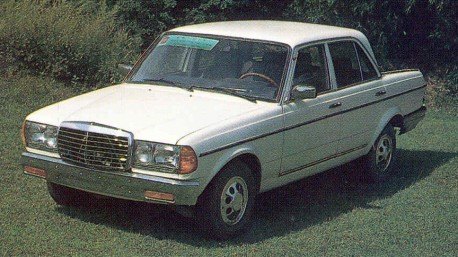Tycho's Illustrated History Of Chinese Cars: The Benz-like Vehicles Of Bamin Auto

The Chinese Army was a great admirer of Benzes, so much that they built their own. Bamin State Automobile Works, or Bamin Automobile for short, was based in Minhou in Fujian Province. The company was owned by the Chinese army, it was also called the ‘PLA 7427 Works’. Bamin Automobile started business in the late 1980′s with a local licensed variant of the Beijing 212; the Bamin BM212A/BM213A.
The design of Bamins was very much inspired by the Mercedes-Benz W123 that was made from 1975 until 1975. But Bamin also liked heartier fare,as evidenced by the Bamin variant of the Russian-style Beijing BJ212:
The five-door variant was called Bamin BM212A, the three-door variant was called the BM213A. On this picture, a BM212A is parked next to an original Beijing BJ212. Bamin made quite a few changes. The soft top from the Beijing was replaced with a hard top and the front window was completely redesigned. Putting personal touches on Russian army jeeps was not enough for Bamin, they wanted more, and that’s when the Benz-like vehicles came in…
The vehicles looked a little jacked-up, and that is because they are based on… the very same BJ212 chassis! Bamin made two variants: a pickup truck and a wagon. They might look like sedans, but they were pickup trucks, made to look like the W123 Mercedes-Benz sedan. The names are even more confusing. The base versions of the pickup and wagon were both called Bamin BM2022A. The more luxurious version of the pickup was called Bamin 1020 KHA (first pic), the more luxurious version of the wagon was called Bamin BM6480. And then there was something in the middle, the vehicle on this photo, called the Bamin BM1020KH.
A Bamin BM2022A, seen by Dutch journalist Jan van der Made in 1994 in Chengdu.
This story would not have been possible without his picture and the incredible archive and memory of the Great Automotive Explorer Erik from ChineseCars.net who provided all the pictures of the old Bamins in this article.
Build quality was so so, but not that bad for the times. The Benz-Bamins and Bamin BM212A/BM213A were all powered by a locally produced variant of the engine that powered the Beijing BJ212; a 2.4 liter four-cylinder with 73hp and 172nm.
Sadly, we don’t know who designed these beauties, and neither do we know how many were made. The Chinese auto industry was a very colorful mess in those days with factories producing whatever they wanted without much regulations in place. In the late 1980′s, there were over 200 ‘car makers’ making cars in China, most didn’t make more than a a few hundred vehicles a year at best. These were the really crazy days that are basically forgotten by now, not only abroad but in China as well. We will make sure at least some vehicles will be remembered.
Production of the Bamin-Benzes ended sometime in the early 1990′s. As far as we know none survived but we might have to go to Fujian to be sure. At the time, most auto makers didn’t sell many cars outside their own province. This is also one of the reasons why knowledge about this period is so limited.
Bamin continued in the late 1990′s with the BM213A, a rather cool looking vehicle based yet again on the BJ212, which was by then renamed to BJ2022. The engine was still the same 2.4 four-cylinder.
The last Bamin ever made was the CJY6420E, based on the BM213A. A much rounder design with a Pajero-inspired front, but in the end it was still the good old BJ212 underneath, powered again by the same 2.4 four-cylinder. The CJY6420E continued all the way until the early 2000′s.
Bamin Automobile survived until 2010 when the company was declared bankrupt. Too bad! Bamin was a great example of the automotive dreamland China once was, but just like so many other small players, Bamin just didn’t have the cash to develop something really new. No government bailout for PLA Works 7427.

More by Tycho de Feyter
Latest Car Reviews
Read moreLatest Product Reviews
Read moreRecent Comments
- Redapple2 Love this gen Toyota. This Celica is up there on my list. Remove mods. ..... and $23 large is a bit too dear.
- Jeff Miss that old bumper sticker "I brake for unicorns."
- Tassos How dare these workers exercise their Constitutional Right to vote and be part of a union!
- EBFlex This is good news. Perhaps the tide is turning against this insanity
- Ravenuer Is it possible Musk is getting a little, you know.......?











































Comments
Join the conversation
As someone who is waiting to inherit the W123 my mom picked up from the factory in 1982 and still drives, I'm fascinated that there is such a close copy out there (not that I'll ever see one in the flesh). I think there is an interesting potential essay on how communist dictatorships changed the capitalist cars they copied over time. My sense is that older communist cars, at least for the elites, were American in style early on, but changed over time. don't know enough to do the topic justice - I'd be interested to know if there really is a trend.
the w123 turbo dsl has a longer final drive / lower ratio, as the engine doesnt rev as much than the big moma 300sd. more nimble than sd. i am partial to sd.